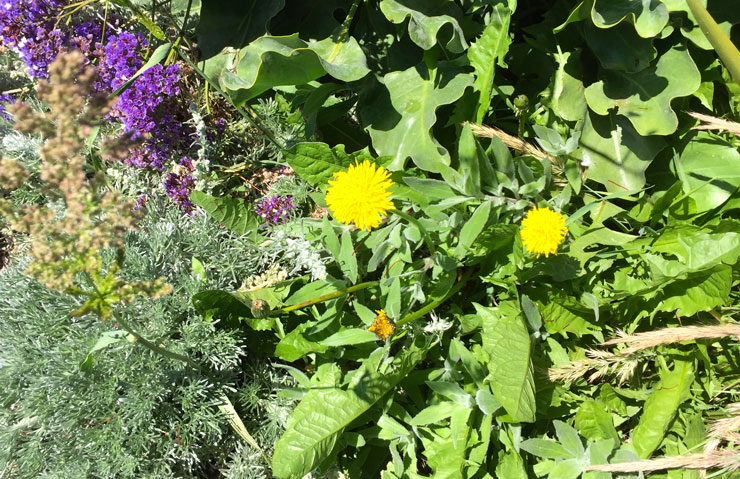
There’s a reason chefs say they’re “in the weeds” when the fast-paced, delicately-balanced dance of the restaurant kitchen becomes hopelessly unmanageable.
I used to be weed-ignorant, and happily so. I now know more about weeds, and the tools and means to deal with them, than I usually care to admit. Along with learning to distinguish between the relatively harmless annual weeds and the pernicious perennials, I’ve also learned tricks for extracting micro-nutrients from those weeds—the better to feed those nutrients back to the soil.
As importantly, when it comes to pulling specific weeds, I know which tool does the job best. In the past, when I was truly “in the weeds,” and near the breaking point, I would struggle with whether or not to spray the weeds with a chemical herbicide. Since I’ve joined the local beekeepers association, that’s no longer an option.
The decision to spray—or not—for weeds, came up recently at Waldo Point Harbor: See Our Voices Have Been Heard. As if reading our minds, the May 19 Sausalito Currents featured a piece outlining reasons why spraying weed killers is a bad idea, along with links and resources to delve further into this topic.
The post itself (below) includes good basic information, along with a link to a helpful site, Yard Smart Marin, where you’ll find even more links. Or, if you’re the curious type, you can head straight down the rabbit hole of specialized weeding tools and alternate solutions here: Fine Gardening—Weeding Made Easy. There are myriad solutions beyond the select tools highlighted—most are very basic (in the underlying principle) and some items, such as vinegar, are common enough you’ll find them in your kitchen pantry.

Weed Killer: Think Before You Spray
Spring has sprung in earnest here in Marin, and that means a bumper crop of weeds along with blossoming flowers, thriving shrubs, and healthy trees. Tackling weeds is a challenge for anyone, but think twice before you reach for a bottle of weed killer.
Why is spraying weed killer a bad idea?
- Commonly used products that kill weeds contain toxic chemicals that don’t just kill undesirable plants, but have residual impacts, harming the soil, and often ending up in our streams and in the Bay.
- When sprayed where pets run, children play, and our neighbors walk, the residual chemicals can be absorbed into bare skin (and paws) and tracked into our homes on our shoes.
- Desirable plants may be unintentionally injured by herbicides via “drift,” spray that moves through the air with even the slightest breeze.
- Some products combine fertilizer and weed killer; these products add unnecessary pesticides to the environment.
What are some other methods to control weeds?
- Hand pulling is one of the most effective methods as weeds first emerge, and it gets everyone out in the garden before spring even arrives.
- Hoeing is also a great way to turn the soil and break up weedy roots.
- Use a “weed whacker” as plants emerge and before they set seeds – this will halt the proliferation of more weeds next season.
- Smother them by covering the weedy area with newspaper or cardboard, then add mulch on top. This kills weeds down to their roots and adds plant nutrients to the soil.
- Use a torch to kill weeds in sidewalk and driveway cracks.
If you must use a chemical weed killer, read the product label to discover the potential hazards for your specific product. All pesticides have labels that include signal words denoting their toxicity.
Visit the website of Yard Smart Marin to learn more about the Think Before You Spray campaign. Yard Smart Marin is a collaborative, community-driven project funded by the County of Marin and the San Francisco Estuary Partnership.